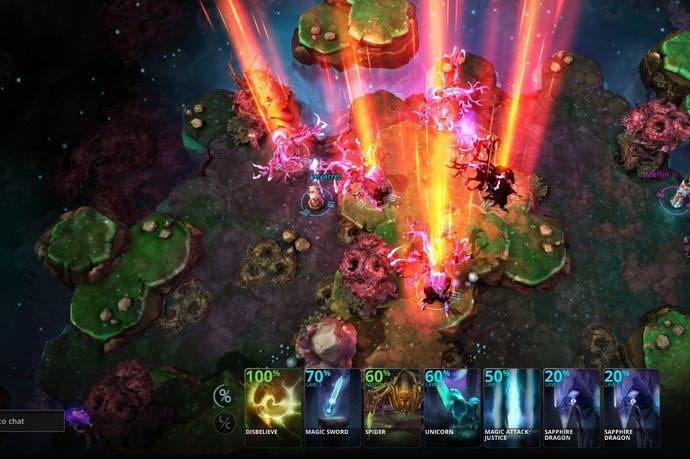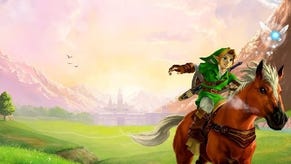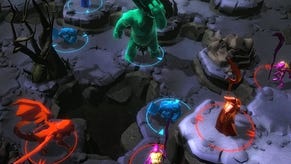Chaos Reborn is a case study in how to revive a classic
Julian Gollop's wizard battling strategy game returns in fine style.
I love Chaos. It's the greatest game ever made. If you scroll down to my little author bio at the bottom of this feature, you'll see that this is a line I've been peddling for quite some time.
Chaos, originally released for the ZX Spectrum in 1985, is brilliant because it creates complex wonders out of very simple rules. Unusually for a fantasy game, that title isn't just used because it sounds cool, but because it sums up the gameplay - and also one of the inescapable laws of the universe - in a single word.
You started with a completely black screen, and between 2 and 8 wizards spaced evenly around the edge. Each wizard has a random selection of spells - some will conjure creatures, others will create hazards or summon enchanted weapons or armour. Each wizard takes it in turn to cast a spell, and then move and attack the others. Last wizard standing wins.
It was beautifully simple, yet the number of spells and the different ways they could shift the dynamic of the arena meant that no two games were the same. From a clean black void to utter mayhem, via simple rules, Chaos is entropy in microcosm.
Simplicity is generally the first thing to go when a classic game is remade for today's market, so I approached Chaos Reborn with no small amount of trepidation. I've always felt there was untapped potential in the game, but was also fearful of how its stripped back clockwork perfection would suffer under the weight of additional systems.
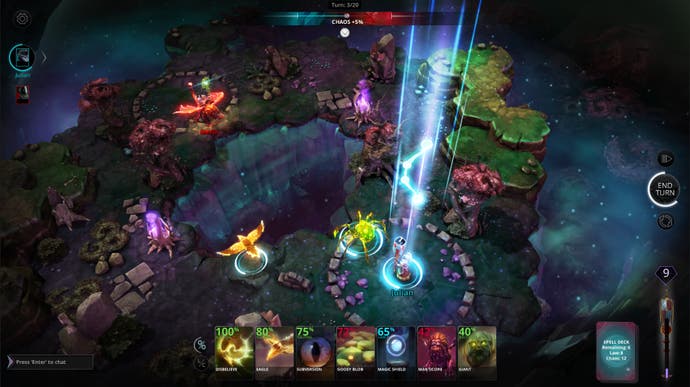
Turns out I shouldn't have worried. Julian Gollop, still probably best known as the creator of the X-COM series, has returned to his past with a keen eye. Chaos Reborn stays thrillingly true to the original template, but where changes and tweaks have been made, they're with a surgeon's precision.
The core concept remains the same: kill the other wizards using your spell selection. Naturally, the stark 8-bit menus of old have been replaced with something more streamlined. Spells are now selected from a deck of cards at the bottom of the screen, and are cast by dragging them into the playing field onto the hexagonal tiles.
The most noticeable change for fans will be the introduction of mana. This magical resource is earned by skipping a turn without casting a spell, moving your wizard to one of the mana shards on the map or by burning off unwanted spell cards.
It's the way that mana is used that is particularly clever, though. In the classic Chaos, every spell had a percentage chance of being successful when cast. This percentage shifted depending on the nature of the card - Law, Chaos or Neutral - and the state of the game world. The more Law spells are cast, the more lawful the world, the easier it is to cast more Law spells. By choosing what to cast and when, you could try to shift the world in your favour, so that a truly powerful spell such as the Golden Dragon would go from a mere 10% chance of success to something more reliable.
The twist was that any creature could be summoned as an illusion, and guaranteed to succeed, but illusory creatures could be instantly vanished through use of the Disbelieve spell - a default spell that every wizard has, and never runs out of.
Illusions and percentage casting rates return in Chaos Reborn, as does the ability to shift the world state through the spells you cast, but the mana system shakes them all up in exciting ways. Your mana reserves can be used to top up the casting chance of any spell, which means that it's now possible to muster your resources in lots of different ways, and cast much harder and more powerful spells earlier in the game.
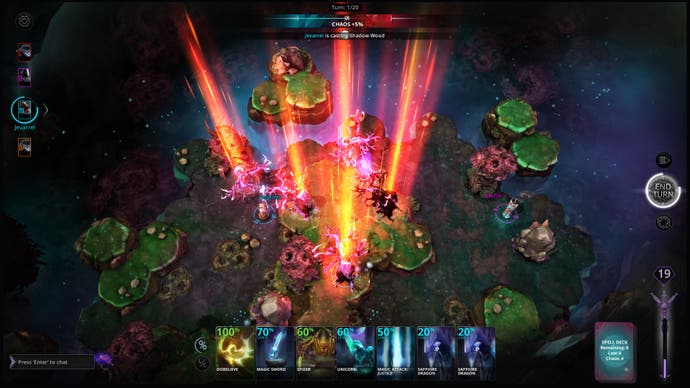
It's a seemingly small change that really alters familiar rhythms - in a good way. One of the weaknesses of the original Chaos was that the more you played, the more certain outcomes became easier to predict. Powerful spells were so rarely real rather than illusion that the Disbelieve spell could be used to mop up the game's best beasts before they'd had a chance to do anything. That's no longer the case.
Another small but fundamental change is that the game is much more agnostic about what you do and when. No longer are you forced to choose a spell, cast a spell and then move. You can now move to a better position before casting, a standard genre practice today that nevertheless opens up whole new tactical avenues where Chaos is concerned, especially as the arena now features higher ground and other terrain features.
The way certain units attack has changed in kind. Flying creatures, for example, can no longer strike from a distance while remaining in place. Whereas once an eagle could hit an enemy six squares away without leaving itself in retaliation range, now they must land next to an enemy in order to do damage. The pay-off is that should a flying creature swoop to attack from higher ground, it does more damage depending on its height.
The game is full of small improvements like this, the sort of stuff that will likely only be noticeable to an 8-bit Chaos obsessive like myself, but that speaks highly of Gollop's grasp on what worked and what could be improved in his three decades old design. Every tweak to the rules has been made to address flaws in the original that only became apparent through protracted play. This is clearly a game that has been updated with passion, care and thought, not simply dusted off to cash in on the current mania for crowdfunded reboots.
Visually, the game is a joy. I'll miss the crudely personable pixel portraits of old, which so effortlessly captured the essence of giants, hydra and giant rats, but they've been replaced by detailed miniatures that are equally dinky but wonderfully detailed. A large part of my pleasure at exploring Chaos Reborn was discovering how old favourites had been reimagined - such as the unicorn, which goes from whimsical mount to blade-headed beast. It's not just the designs that please, either. The idle animations are wonderful - the way a skeleton will juggle his own skull while awaiting his turn - and opposing units left next to each other will spar, jab and dodge rather than simply stand still.
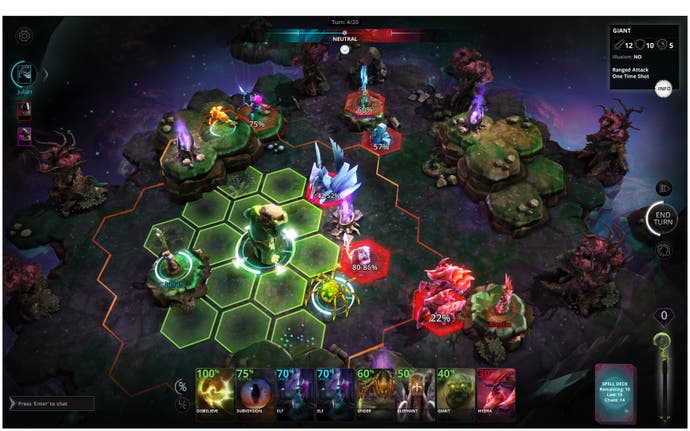
What excites me most, however, is that Chaos Reborn has barely even started. Right now the only game mode available is online multiplayer, the bedrock on which the game will grow. Smart new additions include a 2v2 co-op option, where you team up with another wizard to take down another pair of players, and an asynchronous mode that lets you play a more chess-like game, swapping moves with another player remotely.
Still to come, though, is the offline mode - which will seemingly play most like the original Chaos, with hotseat multiplayer and the option to play solo against AI wizards - and Realms of Chaos, a campaign of sorts which sees you exploring the fantasy kingdom, battling magical enemies in combat bouts, as you work your way up to face a terrible necromancer who wants to rule the world.
Tied into all of this will be what sounds like a subtle but worthwhile seam of RPG progression. Your wizard persists from game to game now, earning XP and levelling up. You'll also be able to equip different clothing and wield different staffs, which will impact the sort of cards that you get in your deck. In other words, while the cards you receive will still be random, if you favour undead creatures or Chaotic magic, you can make sure those are more likely to turn up.
But what matters - and what impresses most - is that Chaos Reborn is already a brilliant update of an absolute classic. The fundamentals have been delivered, the core is rock solid, and Gollop's team at Snapshot Games has proven that it's not about to drown the delicate balance under adhoc changes and thoughtless additions. There's every reason to be excited about Chaos Reborn's future but, unlike too many other Early Access games, it's a game worth being excited about right now as well.
